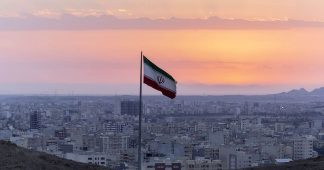Posted on
Iranian Brigadier General Esmail Qaani was sent to Iraq in mid-November with unmistakable instructions from the government that there were to be absolutely no attacks. He “made it clear that Trump wants to drag the region into an open war before leaving…and it is not in our interest to give him any justification to start such a war.”
The Iranian leadership was making sure everyone had their signals straight, so they wouldn’t get provoked into a war they very much did not want. And that took a lot of restraint because they were being buffeted by torrential provocation.
The most recent volley of provocations began ten months ago with the January 23, 2020 assassination of Iranian general Qassem Suleimani while on a diplomatic mission in Iraq, with the US in the role of trigger supported by Israel in the role of gun sight. Suleimani was killed by American hellfire missiles using Israeli intelligence that “confirmed and verified” informants’ information tipping the US off to which plane Suleimani arrived on.
The assassination of Iran’s top military official was followed by a dangerous mid air provocation. On July 23, a civilian Iranian plane had to dive to avoid a collision with two American fighter jets that illegally intercepted it.
Four days later, Israel bombed Iran’s allies in south Lebanon in retaliation for five Hezbollah fighters allegedly crossing into the Israeli occupied Sheba Farms in Lebanon, an allegation not only denied by Hezbollah but doubted in Israel. The bombing of Lebanon has been followed by increasingly brazen and public airstrikes in Syria.
The most brazen strike of all was the July 3 explosion that obliterated the Natanz civilian nuclear enrichment facility. Early sources placed responsibility on Israel. Subsequent reporting, including reporting by The New York Times that cited a “Middle Eastern intelligence official with knowledge of the episode” continue to lay the blame on Israel. Making the case against Israel stronger still, former Israeli defense minister Avigdor Liberman, on July 6, publicly implied that the Middle Eastern intelligence source was Mossad chief Yossi Cohen. A week before the Natanz explosion, on June 26, a more mysterious explosion occurred at a missile production facility near Parchin.
Iran’s leaders felt more and more hunted as Trump sought options for an attack on Iran’s Natanz civilian nuclear enrichment facility, Israel visited Saudi Arabia to sell an attack on Iran – which a nervous and vulnerable Saudi Arabia was too nervous to buy – and American B-52s flew into, and a nuclear powered aircraft carrier sailed into, Iran’s neighborhood. And all of this occurred as Iranians braced themselves under withering clockwork sanctions.
The crude provocations have so far failed to make the more sophisticated Iranians take the bait. Iran is not acting for exactly the same reason as the US and Israel are acting: because Trump’s time is setting, and Biden is on the horizon.
“Officially, Tehran says it does not base its policies on domestic American politics,” Trita Parsi, the Executive Vice President of the Quincy Institute told me. “But its conduct . . . reveals a more pragmatic reality.” Parsi says that “Iran is playing the long game. While it is under pressure to retaliate, it knows that escalation does not serves its interest right now.”
Reese Erlich, the author of The Iran Agenda Today: The Real Story Inside Iran and What’s Wrong with U.S. Policy, told me that, based on his conversations with both reformists and hardliners, or prinicipalists, inside Iran, “The reformists definitely oppose any military response at this time, fearing it will give Trump an excuse to attack Iran overtly. The prinicipalists call [for] a response, but are vague on details because they also realize that US policy may change in a matter of months.”
Though the US and Israel are ratcheting up the maximum pressure – seen as a sign of weakness by Iran as Trump’s time wanes – Iran is straining the muscles of its restraint – hoping, as Biden’s time waxes. Most recently, Iran’s president, Hassan Rouhani, calmly said that “The Iranian nation is smarter than falling into the trap…. They are thinking to create chaos.”
And create chaos they are, testing the limits of possible Iranian restraint.
Four decades ago, when Iranian nuclear scientists started being eliminated one by one, Iran quickly realized that an Israeli program existed to assassinate them. They began to protect their scientists, but the man they most protected was Mohsen Fakhrizadeh. So protected was he that, not only his job, but his very existence, was hidden. He was invisible.
But not invisible enough.
On Friday, November 27, 2020, as Fakhrizadeh was driving in an evasive, circuitous route, he was murdered in a storm of bullets and explosions. Though the sequence of events remain unclear, the general events are clear. A hidden Nissan truck packed with explosives was detonated, stopping the car, while several gunmen emerged and opened fire on Fakhrizadeh. Other accounts have the gunfire coming first followed by the exploding truck. In these accounts the gunfire involved a remote-controlled machine gun. Fakhrizadeh was hit at least three times and died in the hospital. Whatever the order, after forty years of trying, General Mohsen Fakhrizadeh had been assassinated.
Though it is not yet known who killed Fakhrizadeh, he has long been Israel’s most wanted Iranian nuclear scientist. Israel tops the list of those with the motive and the means. Iran has blamed Israel. Israel has not officially taken blame but has come teasingly close to a confession. A senior Israeli official, allegedly involved in the tracking of Fakhrizadeh, told The New York Times that the world should thank Israel for assassinating him and that Israel “would continue to act against the Iranian nuclear program as necessary.” According to reporters at The Times, including Ronen Bergman, an authority on Israeli assassinations, “One American official – along with two other intelligence officials-said that Israel was behind the attack on the scientist. It was unclear how much the United States may have known about the operation in advance, but the two nations are the closest of allies and have long shared intelligence regarding Iran.”
Mohsen Fakhrizadeh was a brigadier general in the Islamic Revolutionary Guard Command. He was Iran’s top nuclear scientist and the father of its nuclear program. He headed up the academic section of Iran’s nuclear program and was the head of the Physics Research Center, working on the design of Iran’s uranium enrichment program. He was currently the head of the Research and Innovation Organization in the Iranian Defense Ministry. The effect of his assassination is more psychological than practical, as he was not part of the new generation of Iranian scientists who had followed in his path.
Israel and the United States have long accused Fakhrizadeh of not being just an academic, but of actively heading up AMAD, Iran’s alleged pursuit of a nuclear weapon prior to 2003. The International Atomic Energy Agency has investigated these claims item by item and never verified them (because they are not true). Netanyahu publicly singled out Fakhrizadeh in April of 2018, identifying him as the leader of the AMAD nuclear weapon program. At the time that he called Fakhrizadeh out, he boastfully told the world to remember that name.
Mohsen Fakhrizadeh is not the first Iranian nuclear scientist to be assassinated. In May of 2003, Meir Dagan, director of the Mossad, and his deputy, Tamir Pardo, began a top secret plan to sabotage Iran’s nuclear program. Pardo’s idea was that Iran would abandon its nuclear program if the cost was greater than the benefit. Israel would see to it that it was. Dagan would raise that cost in six ways: diplomatic pressure, sanctions, support to Iranian opposition groups who wanted to overthrow the government, disrupting nuclear equipment supplies, sabotaging nuclear facilities, and assassinating nuclear scientists.
A list was drawn up, and Fakhrizadeh was first on that list. But he was not the first one to be killed. On January 12, 2010, the Israeli Mossad would detonate a remote controlled bomb planted on a motorcycle next to the car of Massoud Ali-Mohammadi. The bomb killed Ali-Mohammadi, who was one of Iranian’s top physicists. Ten Iranians who were working for the Mossad were arrested. One of them, Jamali Fashi, who had a computer and cell phones that tied him both to Mossad in general and to the assassinations specifically, confessed to being recruited and trained by Mossad to assassinate Ali-Mohammadi.
But even Massoud Ali-Mohammadi may not have been the first. Although he is always the Iranian nuclear scientist to lead of chronologies of Israel’s assassinations, the Iranians place him second. Three years earlier, on January 14, 2007, Ardeshir Hosseinpour a nuclear scientist at the Isfahan uranium plant, died suddenly and mysteriously. His death has been attributed to asphyxiation caused by a gas leak, but, according to Ronen Bergman, “Iranian intelligence is convinced that he was a victim of the Israelis.”
On November 29, 2010, a motorcycle was again used to kill Majid Shahriyari. Motorcycle riders attached a magnetized bomb to his car. The future head of Iran’s Atomic Energy Association, Fereydoun Abbasi-Davani, and his wife escaped being killed in the same way on the same day when they jumped out of their car.
In the fourth assassination attempt with a motorcycle, the Iranian physicist and nuclear scientist Darioush Rezainejad was killed when two gunmen on motorcycles shot him in July 2011. Rezainejad played a key role in Iran’s nuclear program as a senior researcher in the Iranian Atomic Energy Organization. “[A] source in Israel’s intelligence community” told Germany’s Der Spiegal that Mossad was behind the assassination of Rezainejad.
Again employing a motorcycle and a magnetized bomb, this time placed on the roof of the car, Mostafa Ahmadi Roshan, a chemical engineer at Natanz who was involved in purchasing equipment for Iran’s nuclear program, was assassinated on January 12, 2012. Thirteen people found to be working for an Israeli spy ring were arrested.
A slightly different type of assassination would occur in November of 2011. A massive explosion would almost entirely obliterate a Revolutionary Guard base that housed Iran’s long-range Shahab missiles. Among the seventeen people killed was Major General Hassan Tehrani Moqqadam, a pioneer in Iranian missile development and the head of the missile development division. That was the second time there had been an explosion at a Shahab missile base. Time Magazine would reveal that a western intelligence source said that Mossad was behind the explosion.
Two senior officials in the Obama Administration revealed to NBC news that the assassinations were carried out by the Mujahideen-e-Khalq (MEK), an Iranian opposition group that spent many years on America’s terrorist list. They also confirm that the MEK was being financed, armed and trained by the Israeli Mossad. Though some sources, including then CIA director Michael Hayden, deny that any US involvement in the assassinations, the senior officials, and several experts, say that the assassinations were carried out with the awareness of the Obama administration. The Americans also secretly trained and supported the MEK.
Now the first on the list is the last to be killed. The intent of the assassination plan was to sabotage Iran’s nuclear program. The intent may have grown to include drawing Iran into a war before Trump leaves office and a window closes. Iran, so far, has had the wisdom and patience not to retaliate and be drawn in.
* Ted Snider has a graduate degree in philosophy and writes on analyzing patterns in US foreign policy and history.
Published at original.antiwar.com











